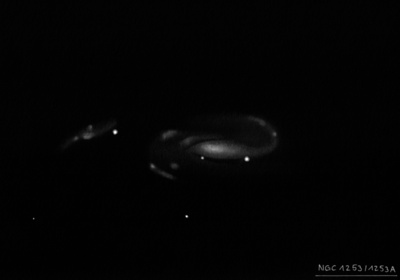
William Herschel discovered NGC 1253 = H IV-17 on 20 Sep 1784 (sweep 280), reporting "a small star with a vF nebulous brush following, discovered with 240x. The brush was faint and about 1.5' or 2' long. A star on each side which viewed were free from that brush that I drew them in the same part of the field." His position was 6' too far south (at the beginning of this sweep, he noted "The rope being broken the PD is coarsely marked in revolutions of the axel"). d'Arrest corrected the position on 4 Jan 1864 and made a total of 4 accurate positions.
400/500mm - 17.5" (1/7/89): moderately bright, oval ~E-W, no central brightening but contains a slightly brighter knot at the NE end. A mag 12 star is involved at the west end 52" from the center and a mag 11 star is 2.9' ENE of center. Forms a double system with NGC 1253A 3.7' ENE (just following the mag 11 star) which was not seen.
600/800mm - 24" (12/1/13): NGC 1253A was picked up as a very faint to faint glow, elongated 2:1 E-W, 0.4'x0.2' (central region seen), low surface brightness. Situated 3.9' ENE of much brighter NGC 1253 and just 0.9' NE of a mag 12 star. NGC 1253 showed a little structure but I didn't take notes.
900/1200mm - 48" (10/23/11): very bright, very large, elongated ~5:2 WSW-ENE, ~4'x1.6'. Contains a large, very bright elongated core that gradually increases to the center. A mag 12.5 star is superimposed just SW of the central region. A spiral arm emerges from the galaxy on the ENE end and curls sharply clockwise towards the SW on the follwing end of the galaxy and quickly dims. The arm appears patchy with a couple of small knots near the outer edge (~1.6' from center). The arm on the west end is harder to make out as it emerges from the central region near the superimposed star and is not as well defined, appearing more as a hazy, mottled region with some brighter patches. A mag 12 star lies 3' ENE and just beyond the star is NGC 1253A, a low surface brightness dwarf. NGC 1253A appeared fairly faint, large, irregular, roughly oval 3:2 E-W, 1.2'x0.8', small brighter core, very patchy appearance (contains HII knots). The nearby mag 12 star is just off the SW side.
Notes by Steve Gottlieb